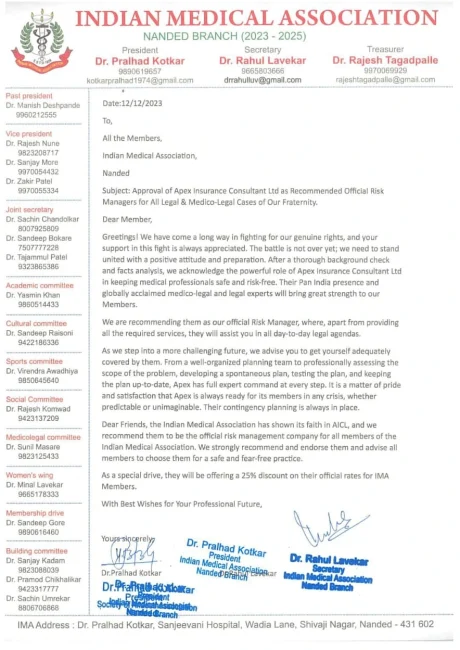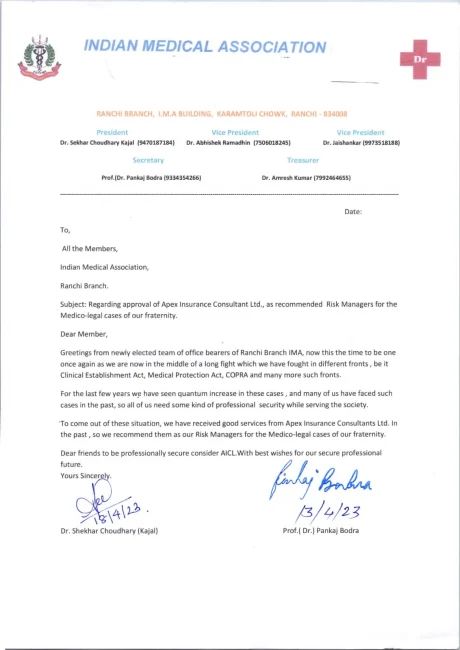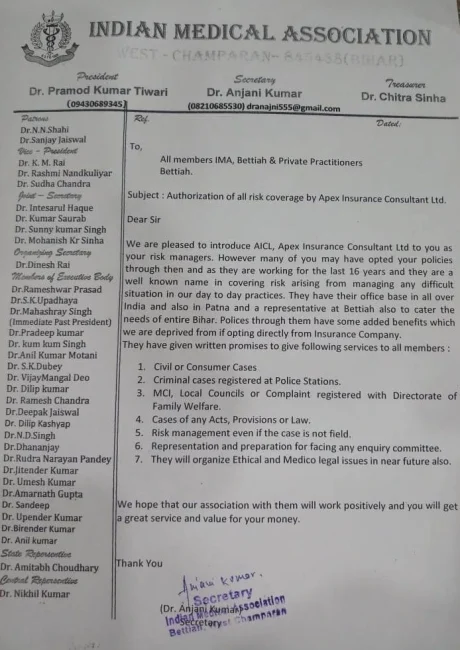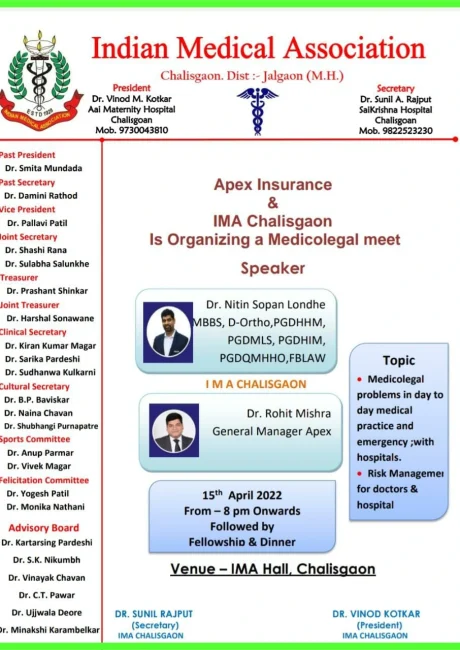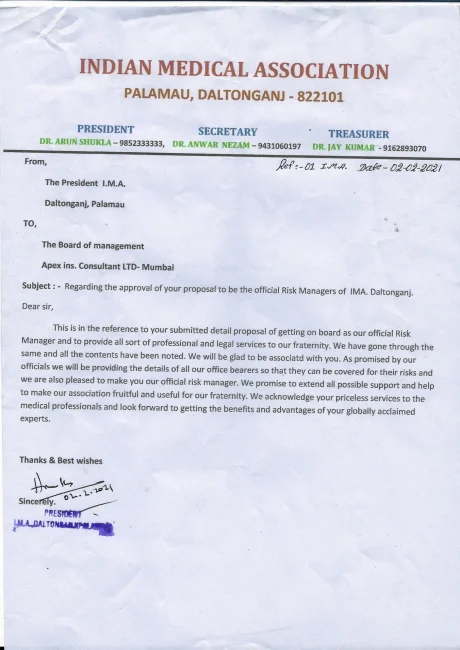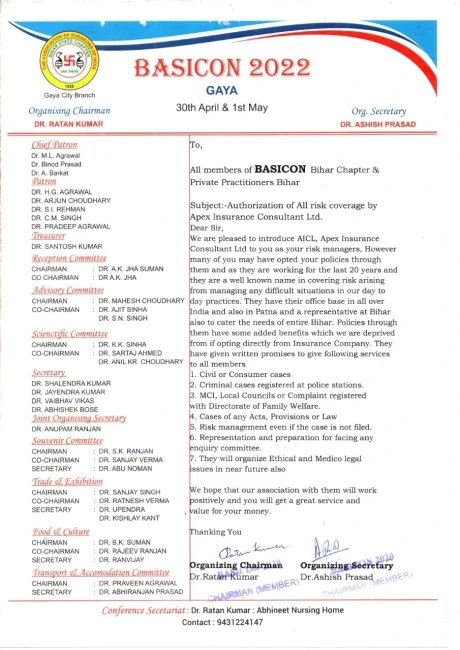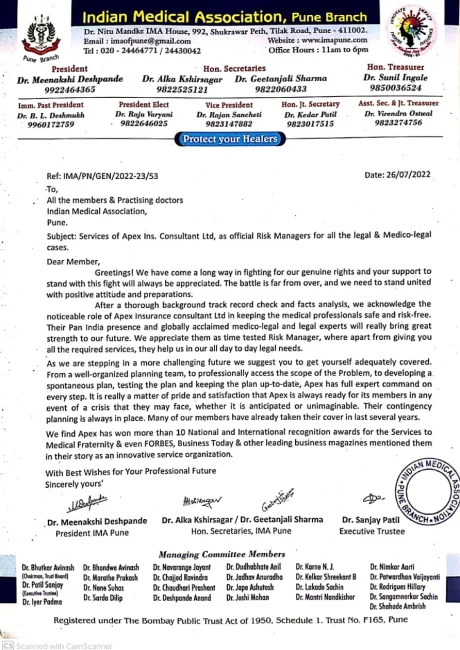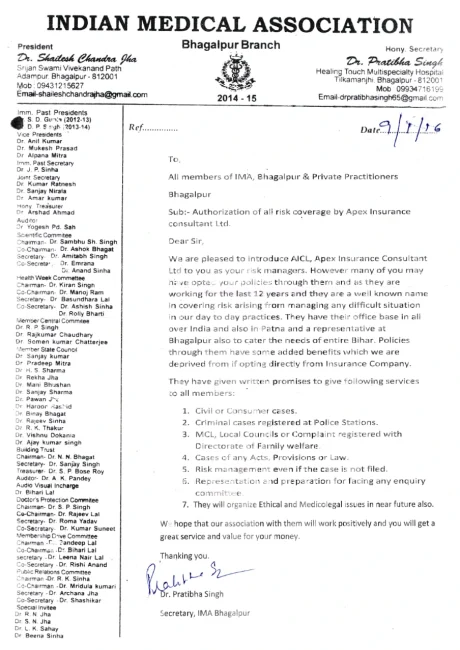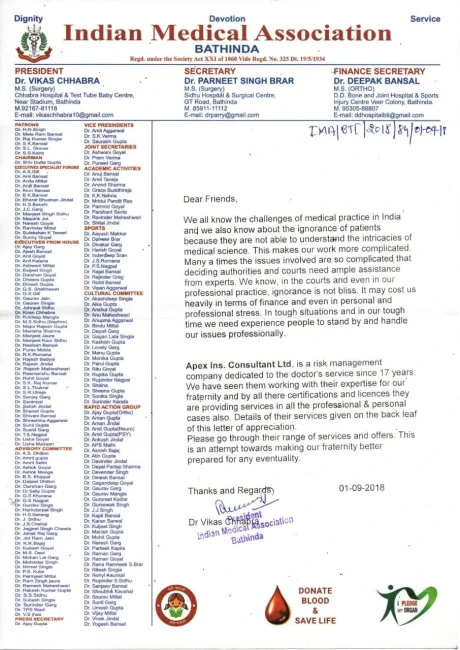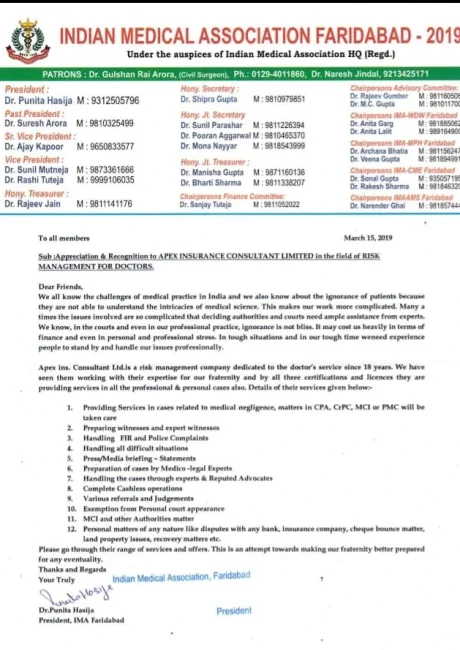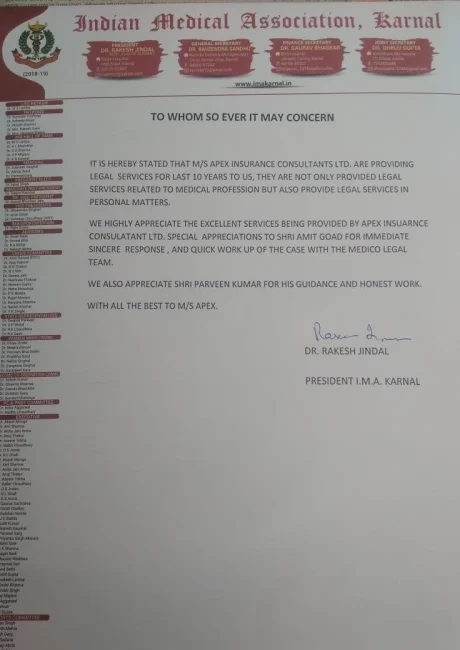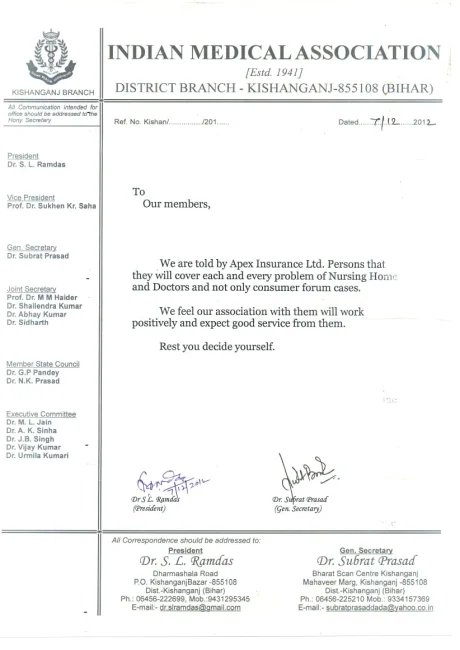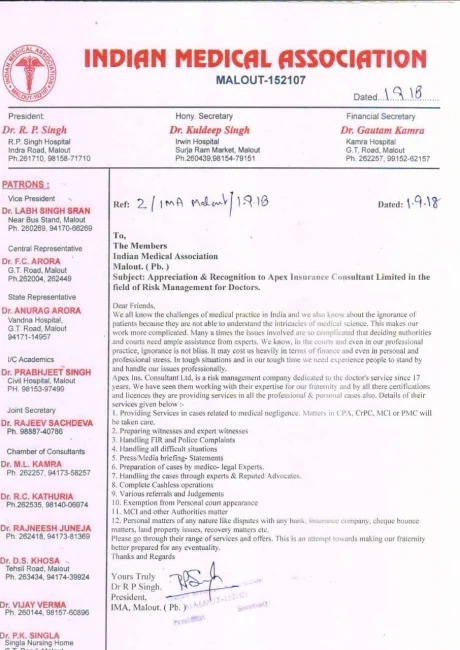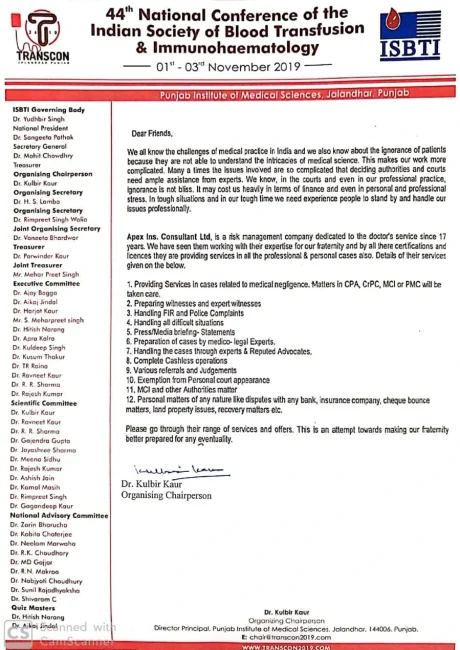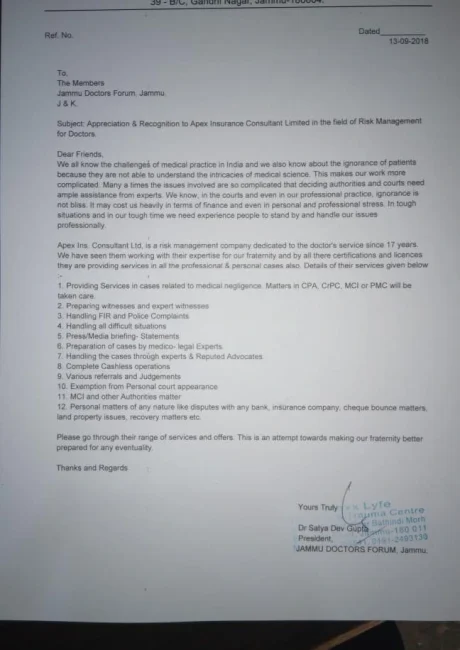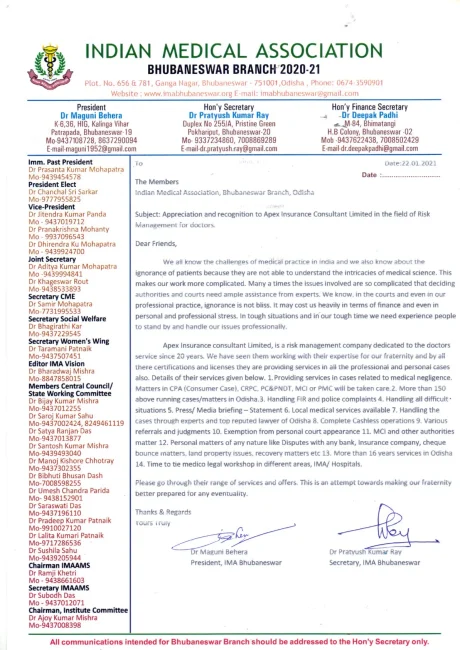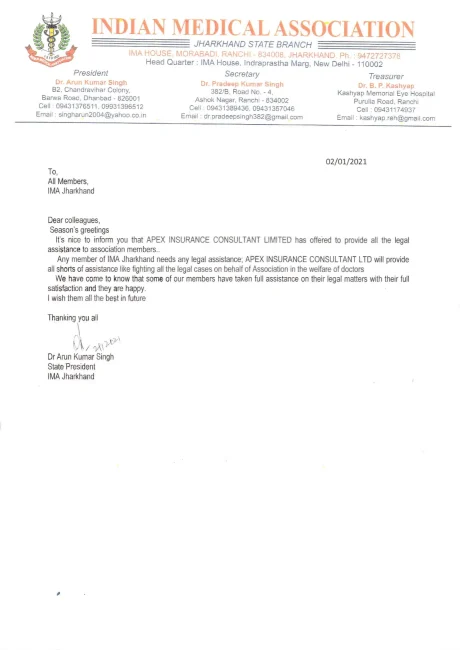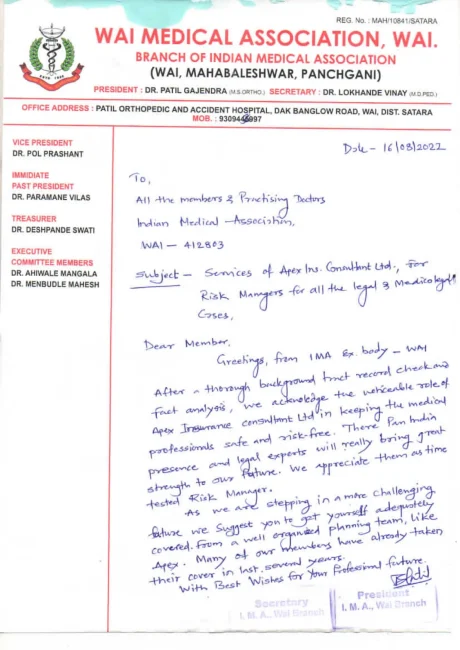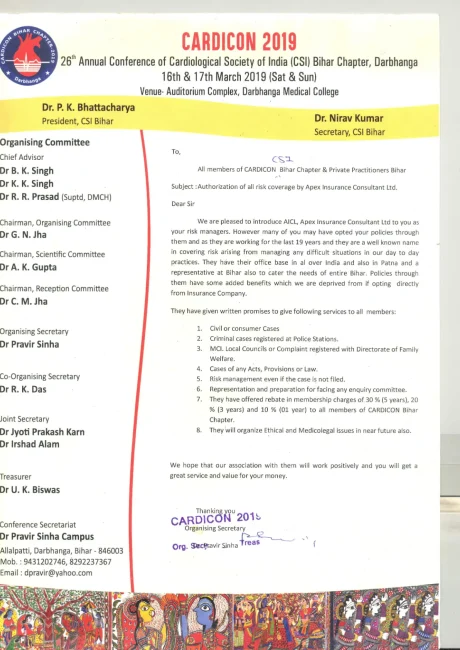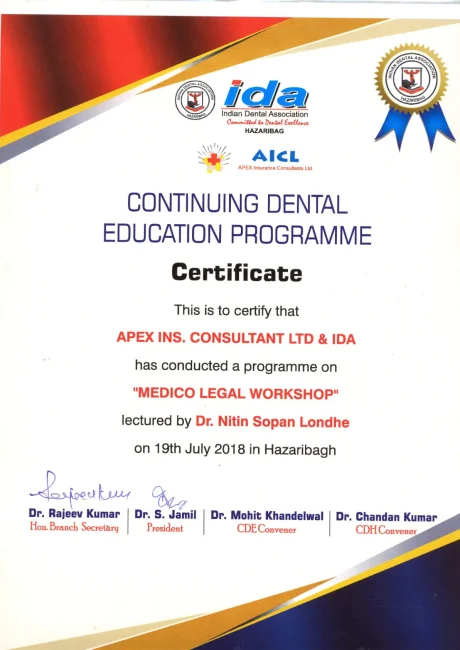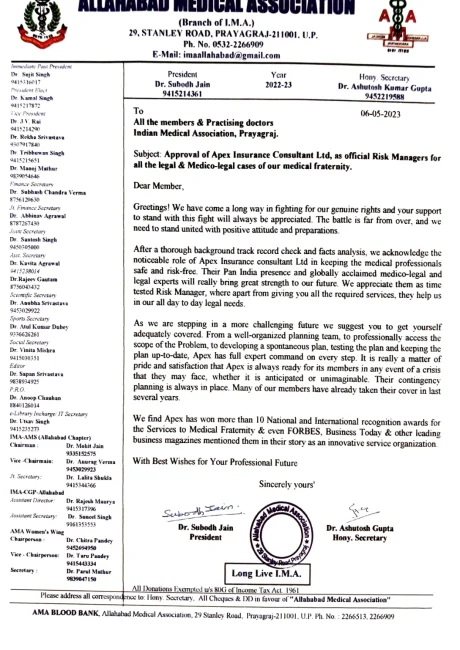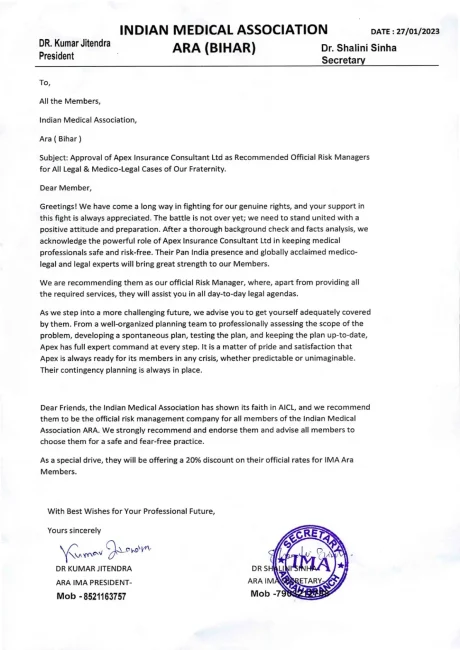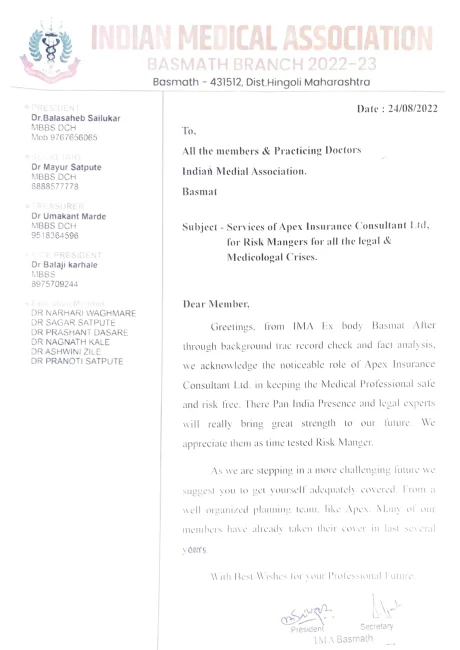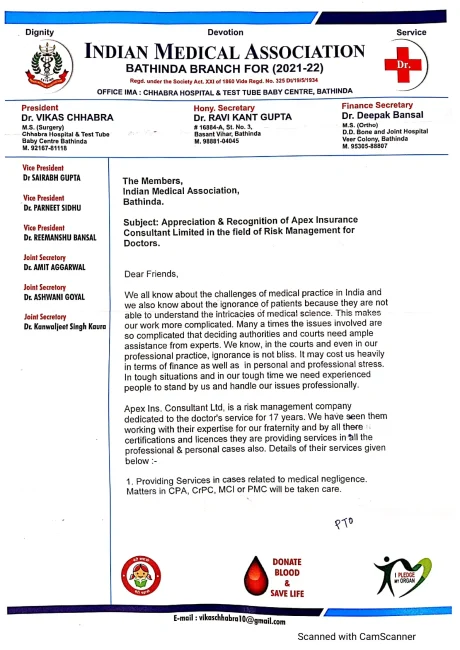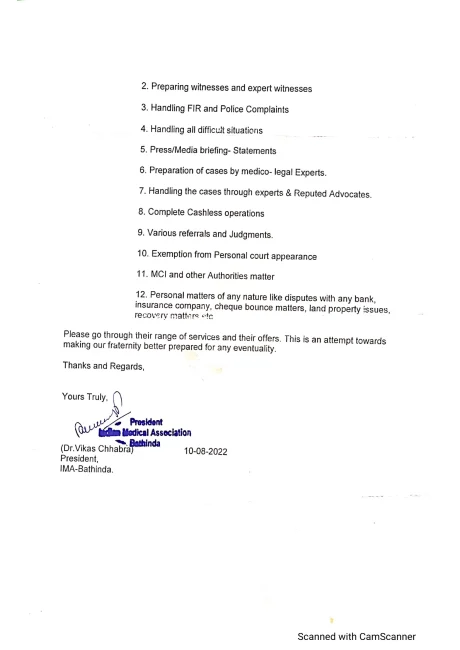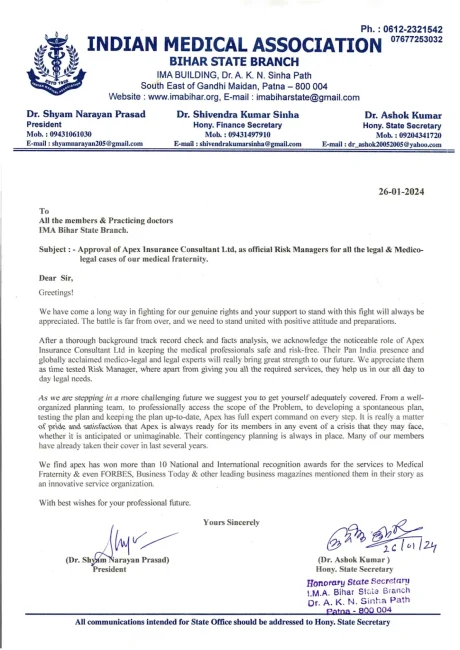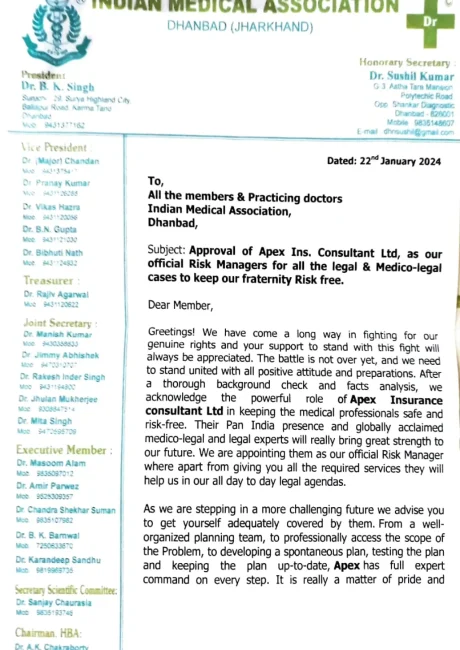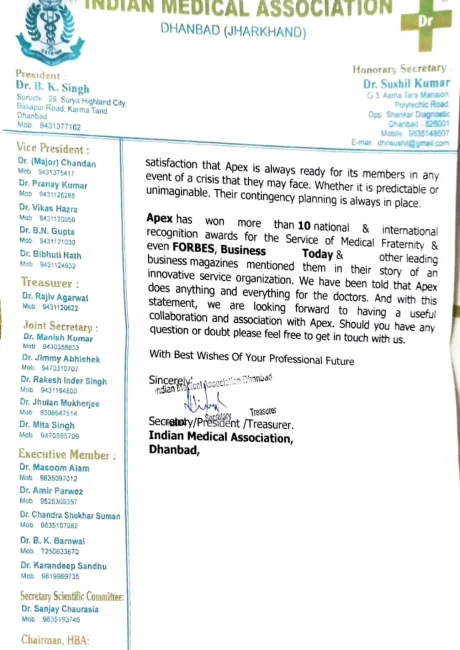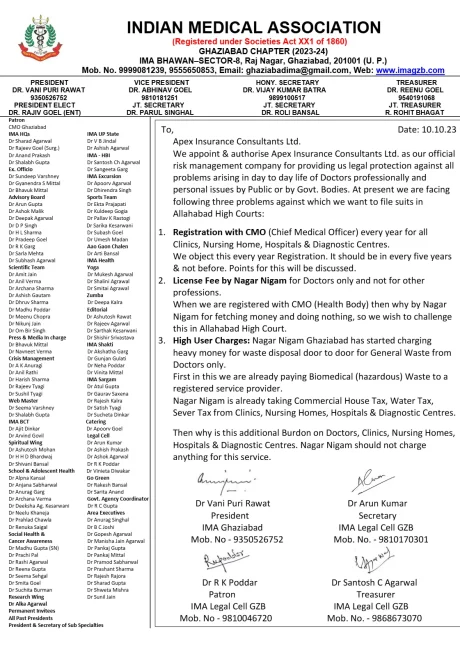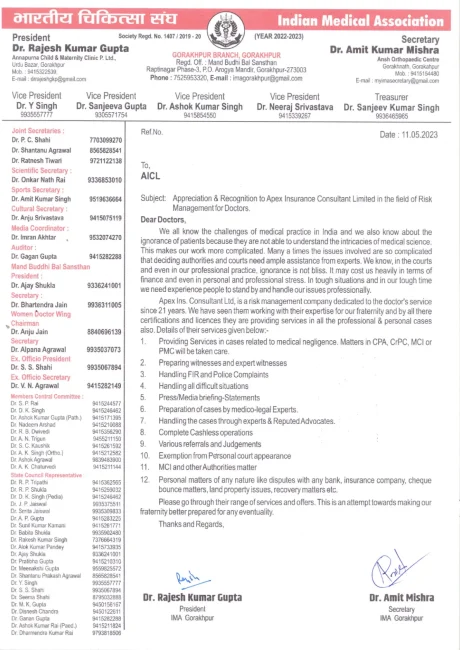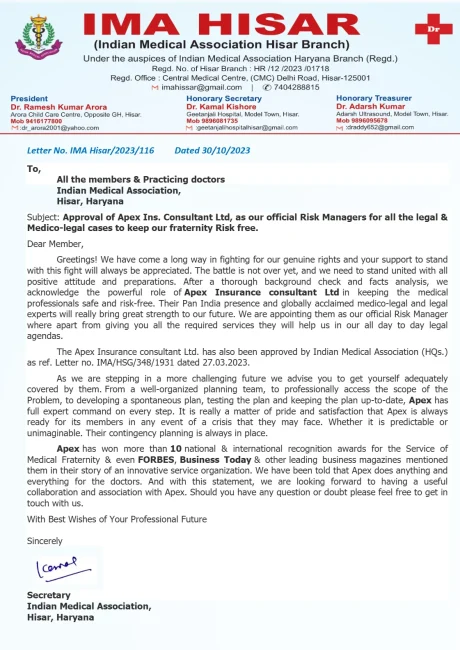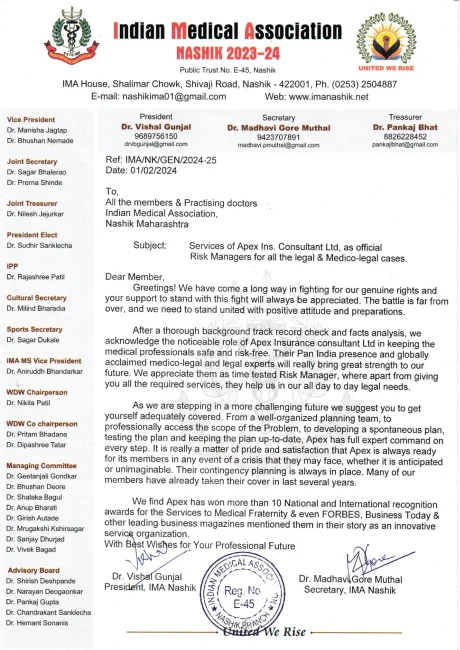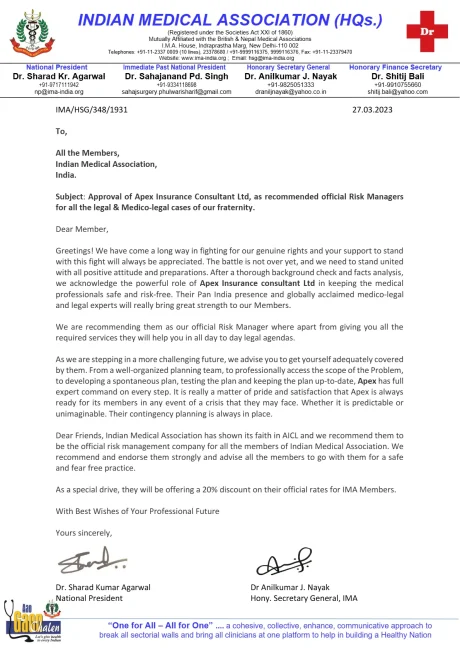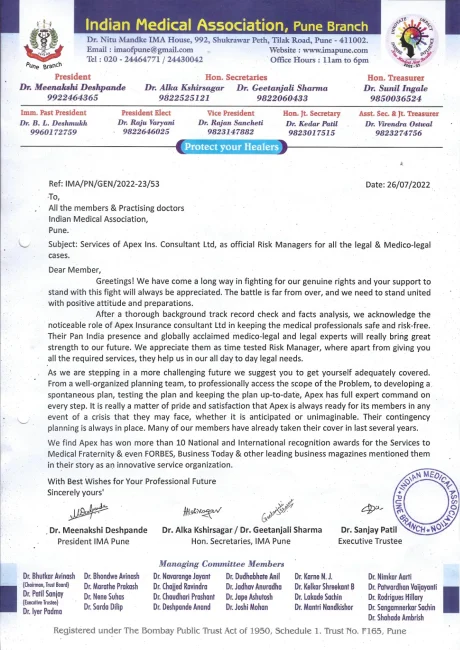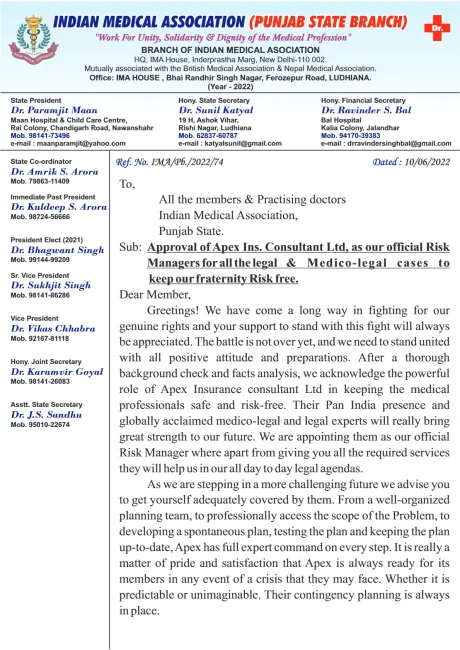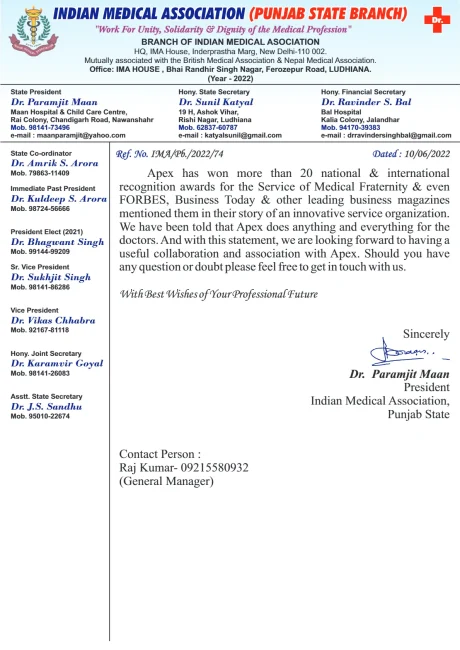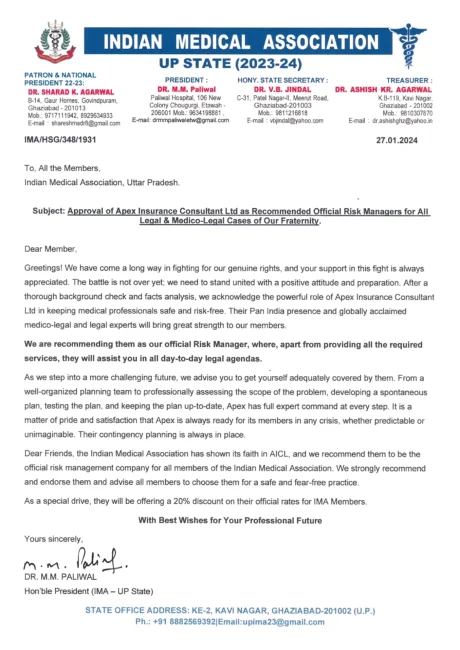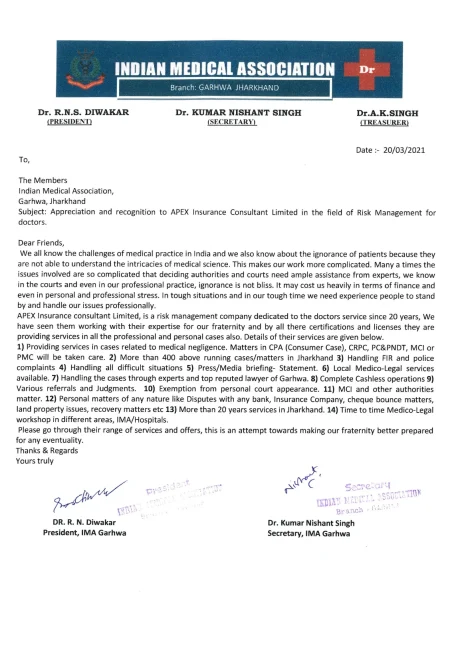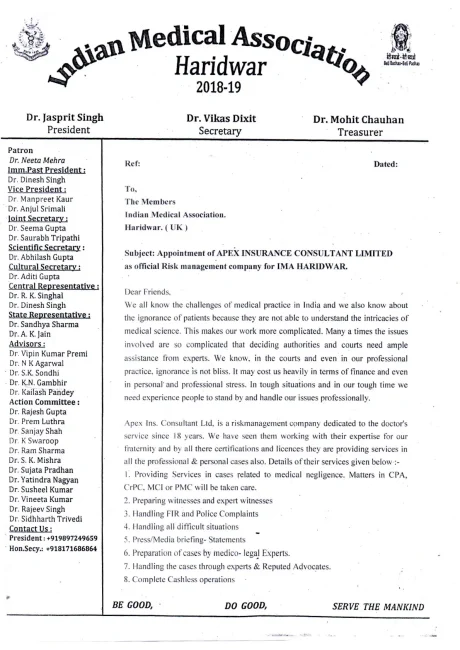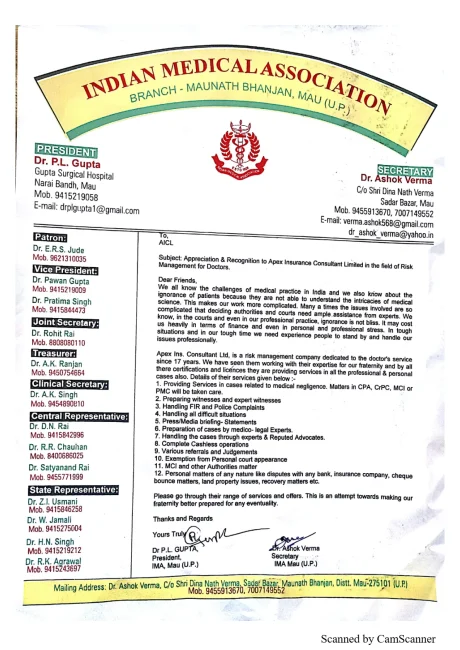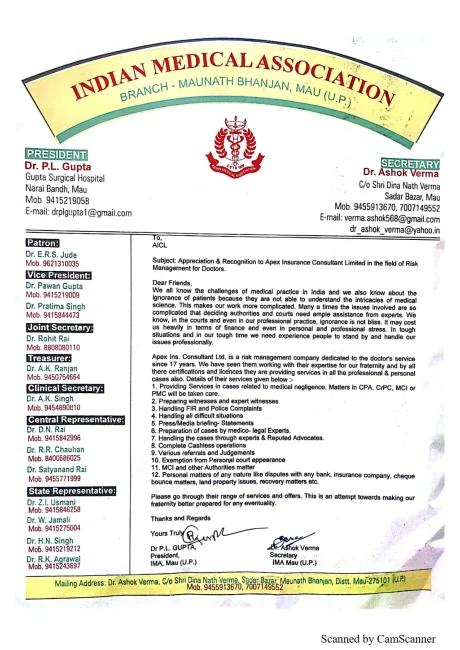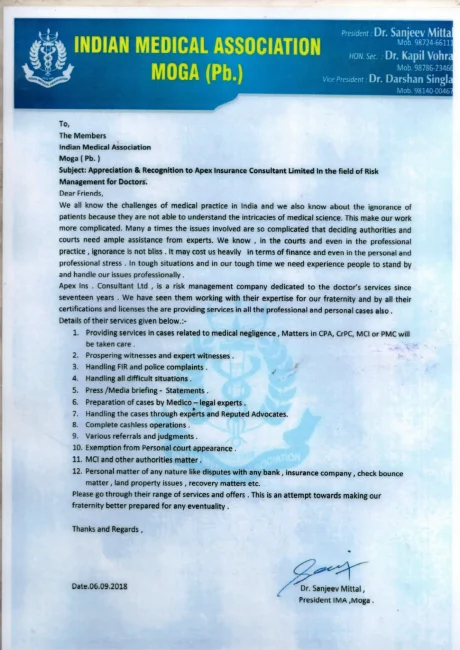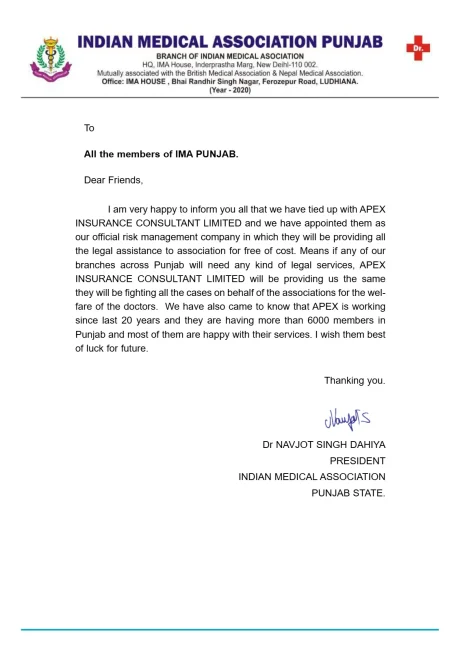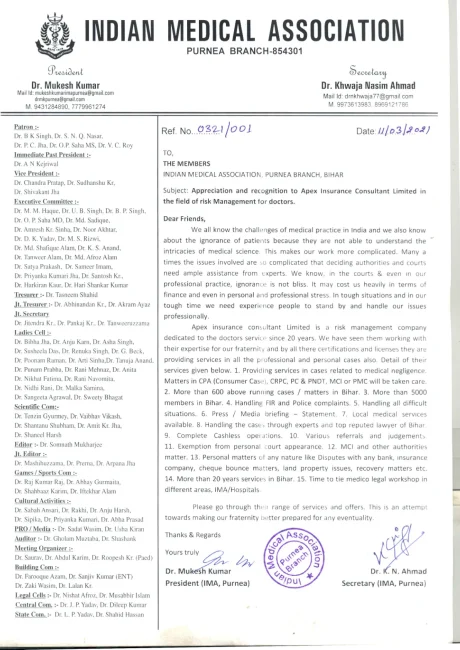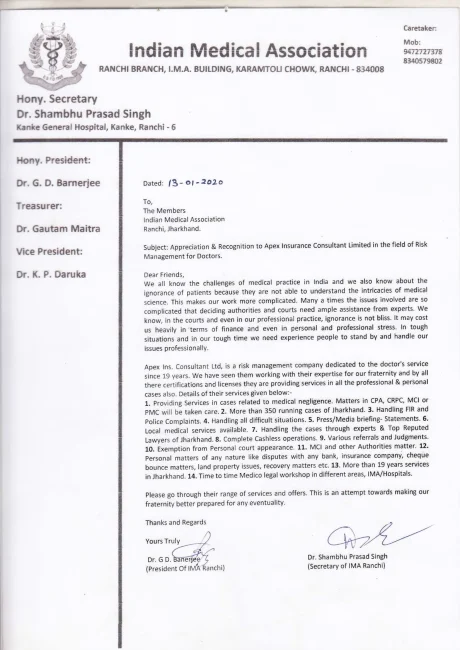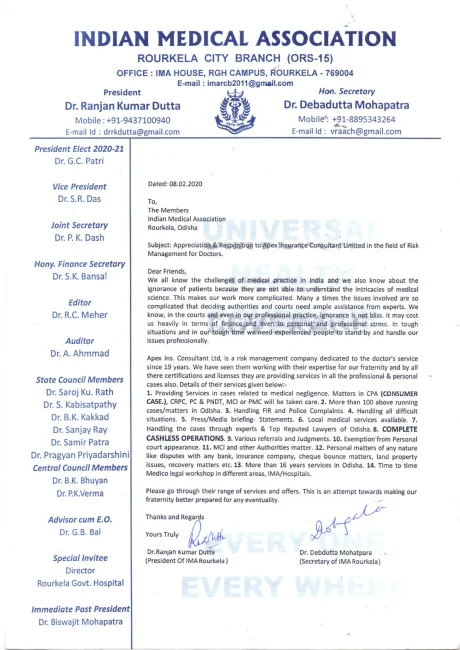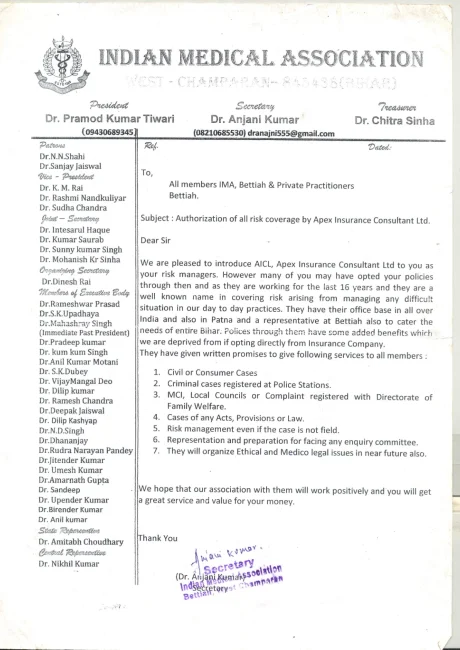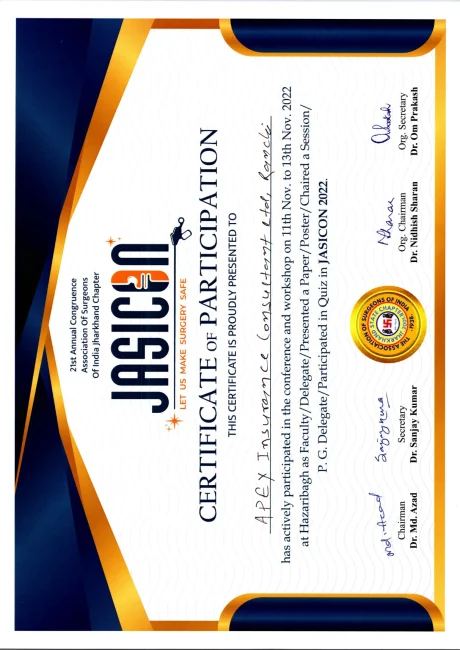By
- Dr. (Prof.) Mahesh Baldwa, M.D, D.C.H, FIAP, MBA, LL.B, LL.M, PhD (law) SENIOR PEDIATRICIAN & MEDICOLEGAL ADVISOR
- Dr Sushila Baldwa, MBBS, MD,DGO, senior gynecologist, Baldwa Hospital, Sumer Nagar, S.V. Road, Borivali (West) Mumbai 400 092
- Dr Namita Padvi, MBBS, MD,DNB, PGDML, Fellowship in pediatric anesthesiology, Assistant Professor of Pediatric medical s at T.N. Pediatric medical College and Nair Hospital, Mumbai-400008
- Dr Varsha Gupta, MBBS, MD, PGDML, department of pathology and blood bank, Bhagwati Hospital, Borivali west, Mumbai-400092
Counseling of patient party is needed to disclose risks and risk associated with patient’s treatment, procedure, surgery and complication of disease, drug and treatment before obtaining informed consent
Subject matter of disclosure before obtaining consent is statement of risks
Risk
Risk may be defined as “exposure to a chance of an injury or loss.”
It embodies two distinct factors:
(1) chance relates to uncertain events, those that are not predictable in any single case, but for which a probability that an event will occur in any one case may be estimated;
(2) injury or loss includes any consequence for which the decision-maker has disutility.
What comes under the meaning of risk?
Risk may be defined as “exposure to a chance of an injury or loss”. Any surgical or medical treatment can cause such an injury or loss.
Duty to inform
the law places obligation to disclose information regarding risks to the party “at risk,” that is, those who will suffer injury if a chance event arises.
Limitation of risk information and decision making
Risks are highly subjective quantities. People perceive risks with biases in their perceptions and make decisions in the face of uncertainty. These limitations militate against consistency and predictability in choices involving uncertainty , even when informed.
Medical informed consent law
Medical informed consent law requires the disclosure of the risks of and alternatives to suggested medical procedures to enable patients to make knowledgeable decisions about the course of their medical care, as under the failure to warn laws, the obligation to inform is placed upon physicians is unclear. Unlike the foregoing laws, however, the consent issue is resolved by looking to what the decision of the reasonable patient at the time of treatment would be.
Proof for non disclosure
In order to recover damages for that bad outcome, the patient must establish the elements of negligence:
(1) the physician had a duty to disclose particular information to the patient;
(2) disclosure did not occur;
(3) (a) but for the nondisclosure, the subjected/undertaken surgery procedure would have been refused, (b) that the tendered procedure was the cause in fact of patient ‘s injury; and
(4) the patient suffered a compensable injury.
Standard of disclosure
“professional standard,” requiring a physician to disclose information that other physicians possessed of the same skills and practicing in the same or a similar community would disclose in the same situation
“materiality” or “prudent patient”
severe consequences, e.g., of death or serious disability, are material and should be disclosed independent of the frequency. “Severe risks (e.g., death, paralysis, loss of lim,amputation, disfiguration of face, vision, hearing, taste, sense or motor disability) should always be disclosed, even when the probability of occurrence is almost negligible.
Non-disclosure Excused
The courts recognize situations where a physician’s nondisclosure will be excused.
When, if a patient is incompetent to make a reasoned decision, then disclosure to the patient may not be required.
Under the therapeutic privilege, the physician may withhold information if disclosure would be upsetting or otherwise would interfere with treatment or adversely affect the condition or recovery of the patient.
Finally, the emergency exception applies in situations where attempting to secure consent could detrimentally delay proper treatment.
More generally, physicians need not disclose risks of which the patient is already aware or risks that are commonly known.
Materiality of Risk Undertaken
The “materiality” says that the physician’s duty to disclose risk information increases as the magnitude of the risk increases.
Further, if risks are of severe consequences, e.g. of death or serious disability, is material and should be disclosed independent of the frequency.
“Severe risks (e.g., death, paralysis, loss of eye sight, hearing and any other a sense organ damage) should always be disclosed, even when the probability of occurrence is almost negligible.
Less severe risks, which have a high incidence of occurrence, likewise should always be disclosed.
Nominal risks with little likelihood of occurrence need not be disclosed.”
Though everyone recognizes that frequency of occurrence, as an important component of risk, yet severity of risk though rare cannot be ignored while disclosure to patient.
Full Disclosure
The courts stress that “full” disclosure.
There are several reasons why full disclosure as a matter of fact is unlikely in medical practice.
First, the number of risks possible from even routine procedures is great.
Second, the burden of identifying small consequence and diminishingly unlikely risks is too great upon the practitioner, and such a listing most likely would seriously impair the resulting choice by the patient.
Indeed, many courts have recognized the bind placed by the law upon the physician, where the disclosure of too much information so as to lead the patient to refuse needed treatment could rise to the level of negligence.23
Implications
The obligation to disclose risk information increases with increasing severity of the potential consequences of complications of disease, drug or surgery.
Consent cannot be substituted for carelessness or un-skilfulness or rash action of doctor legally speaking for any action for negligence. Consent is the basic document that speaks about doctor’s explanation of disease, procedure and risk told to patient. Of course one cannot impose acceptance of un-skilfulness and carelessness and risks arising out of non-availability of prescribed standards for carrying out treatment or procedure or surgery.
Low risks with trivial complications of disease, drug or operation needs no disclosure.
Consent, Risk, Reasonable, Information, Disclosure
Informed consent is the legal embodiment of the concept that each individual has the right to make decisions affecting his or her well-being.
It is generally accepted that individuals should consider — that is, trade-off — the risks and potential benefits flowing from their decisions. To do so, decision-makers must have knowledge of those risks and potential benefits.
The law protects the individual’s right to give informed consent by requiring the disclosure of information by the party to whom consent is given.
Medical Informed Consent
Informed consent law developed from the intentional tort of battery, which protects the individual from an unwanted physical touching of the body by one having neither express nor implied consent of the person touched nor a privilege to do so.
As informed consent became a recognized basis for physician liability, the courts reasoned that any consent based on inadequate information was vitiated by the failure of the physician to disclose.
Lack of informed consent is considered a matter of negligence of the physician to disclose necessary information to patients rather than battery.
Negligence requires that four elements be established for liability of the defendant:
1. A duty of defendant to meet a particular standard of care;
2. Failures to perform that duty;
3. A causal connection between defendant’s failure and patient ’s injury; and
4. An injury in fact, that is, one for which monetary compensation is adequate relief.
Onus of Proof
In order to recover damages for that outcome, the patient must establish the elements of negligence, that:
The physician had a duty to disclose particular information to the patient; Disclosure did not occur; But for the nondisclosure, the tendered procedure would have been refused, and that the tendered procedure was the cause in fact of patient ’s injury; and the patient suffered a injury which can be compensated.
How to describe risk or state to patient?
Risk statement is made as
- 1:100
- 1:1000
- 1:10000
- 1:100000
- 1:1000000
Risk of disease at hand for which patient is seeking treatment, if not treated, what harm it can do?
- Recovery
- Worsening
- Complications of disease
- Morbidity
- Mortality
Risk of recurrence of disease:
- Piles
- Fissure
- Fituala
- Renal stone
- Ureteric stone
- Urinary bladder stone
Risk of failure surgery or invasive procedure
- Tubectomy /sterilization
- Renal stone
- Gall stone
Risk of complications of surgery or invasive procedure
- LSCS
- Hysterectomy
- Salphingo-opherectomy
- Appendix
- Gall bladder
- Prostrate
- Duodenal perforation
- IV contrast dye damaging kidney
Risk of complications of anesthesia
- Anaphylaxis
- Cardiac arrest
- Table death
- Mendelssohn syndrome
- Total spinal
Risk of pre-existing co-morbid conditions which are otherwise silent but for happening of new disease for which patient is seeking treatment ,if not treated ,what harm it can do?
- Obesity
- Diabetes mellitus
- Hypertension
- Hypothyroidism
Risk of concurrent co-morbid conditions
- Pregnancy induced hypertension
- Pregnancy induced diabetes
- Preeclampsia
- Anemia
- Septicemia
- Shock
- Electrolyte imbalance
- Metabolic disturbances
Risk of complication of drugs in terms of adverse drug reactions [Adverse drug reactions (ADRs) are one of the leading causes of death among hospitalized patients and occur in 0.3 to 7 per cent of all hospital admissions] including anaphylaxis and steven Johnson syndrome
Risk of developing anaphylaxis cannot be unidentified most of the cases.
| anaphylaxis | |
| The anaphylaxis is a rare life-threatening hypersensitivity reaction. Anaphylaxis can cause instant death. Anaphylaxis can cause death even after treatment. Its incidence in Europe is 1.5-7.9/1,00,000 person-years. In USA, an age-adjusted incidence rates for male and female are 6.6/1,00,000 male/year and 8.7/1,00,000 female/year, respectively. Anaphylactoid and anaphylactic reactions are clinically difficult to distinguish. Antimicrobials, NSAIDs, and neuromuscular blockers are common causative groups. | |
| major causative groups of medicines | |
| antimicrobials (18.52%)[ β-lactam antibiotics], NSAIDs (12.96%)[ Diclofenac is the most commonly reported NSAID] neuromuscular blockers (12.96%), and anesthetic agents (9.26%). β-lactams (5.96%) were the most commonly incriminated antimicrobials. The most common causative drug was diclofenac (11.11%). Other commonly implicated drugs were atracurium (7.41%), vecuronium (5.56%), ranitidine (5.56%), fentanyl (3.70%), midazolam (3.70%), ceftriaxone (3.70%), artesunate (3.70%), iron sucrose (3.70%) and gelofusine (3.70%). | |
| Among the perioperative cases | |
| neuromuscular blockers (24.13%) and anesthetic agents (13.79%) were commonly incriminated groups. Atracurium (13.79%), vecurnium (10.34%) and ranitidine (10.34%) were common causative drugs. | |
| Route of administration | |
| Intravenous medication produced 74.07% reactions. Other reported routes were oral (14.81%), intramuscular (5.56%), intracervical (1.85%), intraurethral (1.85%) and intraspinal (1.85%). | |
| presentation | |
| Cardiovascular features dominated presentation “Immediate/soon after the administration of the drug (25.93%)” and “within few min (11.11%).” It was within 1-5 min in 18.52%, >5-30 min in 24.07%, >30 min in 11.11% and not stated in 9.26% cases. | combination of cardiovascular and respiratory features (20.37%). The common presenting features were hypotension (81.48%), difficulty in breathing (74.07%), tachycardia (42.59%), pruritus (33.33%), morbilliform rash (29.63%), urticaria (25.93%) and wheezing (20.37%) |
| treatment | Adjunct treatment |
| recent systematic review for the management of anaphylaxis suggests prompt administration of adrenaline may be life-saving. | recent systematic review did not identify role of steroids and antihistaminics in the management of anaphylaxis |
| pregnancy was the most common co-morbid condition of anaphylaxis | |
| iron sucrose is the commonly incriminated drug during pregnancy | |
| Complications of anaphylaxis | |
| Hypoxic brain injury and renal failure had been reported as complications of anaphylaxis | |
Disclosure of risks about peculiar risks of anatomy and visibility
Normal Anatomical deviations of organs and minor unforeseen congenital deviations or malformations
- Abnormal congenital minor or major anatomical change found during surgery
Unforeseen Adhesions of organs
- Due to previous surgery adhesions causing abnormal minor or major anatomical deviations found during surgery
- adhesions causing separation and access to organs difficult during surgery
Nature of visibility during surgery, operation, procedure
- open under vision
- minimal access vision
- virtual vision under microscope or laparoscope
- Blind procedure / surgery
- like D and C, lumber puncture, spinal anesthesia, retro- bulber injection
Guarantee
One has to disclose that there cannot be any guarantee, warrantee and assurance regarding cure or success of treatment. It is unethical to enter into a contract of “no cure no payment”
CONCEPT OF MATERIALITY OF RISK
This also known as forewarning about risks or disclosure of risks to patient party during counseling before consent. The rule is- if not disclosed by physician then patient will have to actually suffer materially because of non-disclosure as cause effect relationship. Just hypothetical proposition in allegation to match non disclosure to negligence is not a material risk. For the individual physician concerned about the scope of disclosure, a useful strategy is to understand the concept of materiality used by courts in USA. The practical inquiry is that if a family member were having surgery, what information would be deemed relevant and important in affecting the decision to have surgery performed by the selected physician. This inquiry will help identify the extent and types of disclosure relevant to the situation such that the patient has all the resources to make an enlightened decision while avoiding information overload. Clearly, this is an area of healthcare law that will continue to expand in the years ahead as consumer access to professional information continues to grow.
Disclosure of risk of Physician inexperience is required in USA
In practice, the definition of surgeon experience or inexperience is fraught with practical difficulty; for example, a surgeon may be well experienced in performing surgery around a given anatomic location although he or she may not have performed the specific procedure in question. Meaningful disclosure of physician inexperience would address since many a times surgeon has not performed procedure hence success rate may be remote and attended by complications. In summary, recent case law suggests disclosure of surgeon experience is not always necessary, but in cases of substantial inexperience or disadvantage, failure to disclose may be construed as a breach of informed consent.
Case laws on inexperience in USA
a. No experience with the equipment used: need disclosure
In Degennaro v Tandom, a defendant dentist neglected to tell the patient that she had no experience with the equipment used and that she typically relied on an assistant when performing the procedure. The patient sustained a serious tongue injury, and the Connecticut court held- inexperience must be disclosed.
b. Not done that type of surgery recently- inexperience : need disclosure
In Barriocanal v Gibbs, a medical negligence/wrongful death action involved a defendant neurosurgeon who failed to disclose that he had not done that type of surgery recently, that the hospital was thinly staffed over a holiday weekend, and that other nearby hospitals had more expertise in that type of brain surgery. Court held -disclosure of provider-specific information was mandatory.
c. Performed just one similar operation in the past 3 years – inexperience : need disclosure
In Goldberg v Boone, a Maryland court considered a medical negligence claim against a surgeon who performed a revision mastoidectomy that led to brain injury. The issue was whether the surgeon should have told the patient that he had performed just one similar operation in the past 3 years and that more experienced surgeons were available nearby.
Disclosure of risk of Physician Health and Disability: No need.
Should physicians be required to disclose matters pertaining to personal health, especially if matters related to physician health may increase the risk of harm to the patient? The opinions cited some interesting hypothetical situations, noting the “impossibility of defining which of a professional’s life factors would be subject to such a disclosure requirement.”
a. Drug abuse
In Albany Urology Clinic v Cleveland, the court dealt with a negligence claim against urologist with a history of cocaine use outside of work and while not on call. The patient, unable to have intercourse after surgery for penile cancer, argued that the doctor had a duty to reveal his drug use history. No need.
b. Alcohol abuse
In Hidding v Williams, a Louisiana court considered a negligence claim against an orthopaedic surgeon in which the patient sustained neurological injury after spine surgery and alleged that the doctor should have disclosed his alcohol abuse history that had led to a prior medical license suspension and divorce. No need.
c. Non disclosure of Raynaud’s syndrome
In Hawk v Chattanooga Orthopaedic Group, a patient injured during a THA later discovered that the surgeon had Raynaud’s syndrome that affected surgeon’s hand should have been disclosed. No need.
d. Non disclosure of history of strokes
In May v Cusick, a surgeon was accused of failing to share his history of strokes; he had two minor strokes in the past with full recovery. No need.
e. Non disclosure of epilepsy
The relationship between disclosure and alleged injury was examined by the court in Halkyard v Mathew; the surgeon was accused of negligently performing a hysterectomy that led to complications. The patient, a nurse, said that if she had known of the doctor’s history of epilepsy, she would have picked a different doctor. The surgeon had not had an epileptic seizure, and the outcome was unrelated to epilepsy or the use of medications to treat such. The court ruled that no liability. No need.
f. Non disclosure of HIV status: No need.
i. Breast surgeon
In Faya v Almaraz, a Maryland court ruled that a HIV-positive oncology surgeon who performed breast surgery was negligent in not disclosing his HIV status during the informed consent . The foreseeability of disease transmission was central to the court’s opinion, although the risk was remote.
ii. ENT
In Estate of Behringer v Medical Center of Princeton, a HIV-positive otolaryngologist was required by the medical center where he had staff privileges to report his HIV status to surgical patients as a condition of obtaining consent . When the doctor challenged this requirement, the court used a reasonable patient standard to rule that the doctor’s seropositive status would be material in deciding whether to choose that surgeon.
iii. Ortho surgeon
In Scoles v Mercy Health Corp, a Pennsylvania court considered the claims of a HIV-positive orthopaedic surgeon against healthcare institutions that prohibited him from performing surgery without the patient’s informed consent regarding his HIV status [44]. Although the case did not invoke issues related to informed consent directly, the court noted that the institutions had reasonably decided that the surgeon’s patients should not undergo an invasive procedure without knowledge of his HIV status.
Disclosure of risk of Physician Training and Qualifications: No need.
Case laws indicates that physician experience and information related to specific qualifications and training of operating room staff, residents, and personnel assisting during a medical procedure do not need to be specifically disclosed.
a. no obligation to Surgeon’s qualifications
In Ditto v McCurdy, a Hawaii court relied on the state’s informed consent law to determine that a surgeon had no duty to reveal his qualifications to the patient before surgery.
b. no obligation to Anesthesia qualifications of OT personnel
in Zimmerman v New York City Health and Hospital Corp, disclosure of a nurse anesthetist, student physician, resident physician to administer anesthesia during surgery.
c. no obligation to Radiology resident moonlighting in a walk-in emergency facility
In Thomas v Wilfac, a Washington state court considered the case of a radiology resident moonlighting in a walk-in emergency facility; at issue was lack of disclosure that the resident was not a specialist in emergency medicine.
d. no obligation to disclose the resident role
In Dingle v Belin, for example, a Maryland court considered an informed consent claim based on resident participation in gallbladder surgery; the court found no obligation to disclose the resident role in obtaining the classic informed consent .
e. no obligation to physician assistant role
in Prissel v Physicians Ins Co, a Wisconsin court was faced with an experienced coronary bypass surgeon who had failed to disclose the role of a physician assistant during the operation.
f. second-year resident performed the delivery is hospital custom & practices
In Henry v Bronx Lebanon Medical Center, the court considered post-delivery complications that occurred when a second-year resident performed the delivery under the supervision of an attending doctor.
Disclosure of Physician Disciplinary History: No need.
Judicial decisions related to disclosure of physician disciplinary history are sparse, and most have assumed that such information is subsumed in the practice privileges and credentialing process such that no physician disclosure is required during informed consent.
a. physician
in Curran v Buser, a Nebraska court interpreted the state statute regarding informed consent as encompassing a professional-friendly theory of the underlying doctrine . Disclosures related to physician disciplinary history not required.
b. dentist
In Ex parte Mendel, a court in Alabama considered a dental negligence claim in which the accused dentist had an extensive history of license suspensions and revocations . The injured patient requested discovery of this information from the Alabama Dental Board. The court held that the requested discovery was appropriate under the state Medical Liability Act and commented that “we will assume, but need not decide on the basis of nondisclosure.
Disclosure of FDA Status of a Medical Device: No need.
A patient enrolled in an experimental study concerning a device not yet approved by the FDA is entitled to full disclosure of the experimental nature of the study. However, if a patient’s surgical procedure uses the implantation of hardware that is not FDA-approved, or is FDA-approved for another purpose, or is experimental, must the patient be so advised by the surgeon to provide informed consent? Generally no. although most court opinions related to disclosure of FDA status of a medical device have clarified that FDA classifications are for regulatory purposes only, a number of legal cases have in fact allowed admissibility of FDA status as one factor to be considered during litigation. Therefore, a prudent rule that emerges from this review is that FDA-regulatory status of a device should be disclosed during informed consent, especially if the device is not FDA-approved for the particular application in which the physician plans its use.
a. Orthopaedic Bone Screw
In Orthopaedic Bone Screw Products Liability Litigation, a Florida court held that disclosure of FDA status is not required, because such status is not a medical risk of surgery.
b. Surgical screws
in Alvarez v Smith, another Florida case involving the alleged implantation of surgical screws in the patient’s spine, in which such pedicle screws were not FDA-approved for that procedure .
in Blazoski v Cook, a New Jersey court held that disclosure of FDA status was not required during informed consent when a patient sustained injury from failure of implanted pedicle screws that were not FDA-approved for the procedure.
c. off-label use of bone plates and screws is not material risk
In Klein v Biscup, an Ohio court considered the off-label use of bone plates and screws and also found that such use was not a material risk that required disclosure before obtaining informed consent.
d. FDA-regulatory status not mandatory disclosure
In Southard v Temple University Hospital, the Supreme Court of Pennsylvania revisited the nondisclosure of the FDA-regulatory status of bone screws and rods. The court affirmed previous case law by commenting that the category into which the FDA places the device for marketing and labeling purposes simply does not enlighten the patient as to the nature or seriousness of the proposed operation. Accordingly, FDA-regulatory status is not a topic for mandatory disclosure under the doctrine of informed consent.
Disclosure of Statistics Related to Outcomes: No need.
Should the patient be informed about the probabilities of success versus failure during informed consent for surgery? Taken to an extreme, should doctors be required to tell patients about the small but foreseeable risk of negligent performance of surgery?
Statistics are impersonal and unreliable when applied to the fate of the individual patient. Court opinions have held that there is no general duty on the part of physicians to share statistics related to the odds of success of a procedure. The relevant cases recognize the uncertainty attendant to the outcome of any medical procedure and the difficulty in relating variables such as survival rates, physician experience, and statistical odds in predicting the success or failure of a specific procedure.
a. no duty to disclose the risk of negligence in the performance of a medical procedure
Colorado courts in Mallett v Pirkey and more recently in Hall v Frankel have ruled that doctors have no duty to disclose the risk of negligence in the performance of a medical procedure.
b. Is physician required to present known statistics, related to the success, failure, complication rate, and mortality of a procedure, during informed consent?
There is no general duty on the part of the doctor to disclose statistical outcomes related to an operation.
In Arato v Avedon, the Supreme Court of California considered an informed consent claim based on the defendant’s alleged failure to disclose life expectancy rates for patients with pancreatic cancer . A pancreatic tumor was incidentally diagnosed during kidney removal surgery, and the patient was referred to an oncology practice for treatment. Before starting therapy, none of the physicians specifically disclosed the high statistical mortality rate associated with pancreatic cancer. The court declined to endorse the mandatory disclosure of life expectancy probabilities, noting that these statistics are impersonal and unreliable when applied to the fate of the individual patient.
c. Not disclosed kidney transplant success rate
Wlosinksi v Cohn reflects a variation of this theme; there, a Michigan court encountered a patient who had postoperative complications and failure of a transplanted kidney . The transplanted kidney was removed, dialysis was started, and the patient died after stopping dialysis. physician’s raw success rates do not constitute risk information reasonably related to a patient’s medical procedure.
d. Statistical evidence allowed
In Johnson v Kokemoor, the Supreme Court of Wisconsin considered an informed consent claim in connection with a surgery to repair a brain aneurysm . The patient sustained postoperative neurological complications. One issue in the case was whether the inexperienced physician was obligated to disclose surgical morbidity and mortality rates to obtain informed consent. Expert testimony said that the morbidity and mortality rate expected when a surgeon with the defendant’s experience did the surgery substantially exceeded the rate expected when a more experienced physician performed the same surgery. The court reasoned that an informed patient might well have elected to forego surgery with the defendant. Although reluctant to adopt a mandatory informed consent comparative risk statistics disclosure rule, the court nonetheless said that “when different physicians have substantially different success rates with the same procedure and a reasonable person in the patient’s position would consider such information material, the circuit court may admit this statistical evidence” for the informed consent analysis.
Disclosure Related to Research and Financial Interests: prudent
Court opinions suggest that information related to research and financial interests should be disclosed during informed consent, particularly if that information has any relationship to the professional activity of the physician. With changing physician-hospital relationships, and the emergence of new healthcare delivery models such as “accountable care organizations,” physician incentives, loyalties, and financial alignments will change in the future. An honest disclosure of these relationships while obtaining informed consent is prudent.
Must physicians disclose their potential conflicts in terms of underlying financial interests or research goals when signing patients for surgery? Moore v Regents of the University of California is the classic legal case in this field; a patient with leukemia being treated at UCLA gave blood, tissues, and other samples, including the spleen, as part of a treatment protocol . Unknown to the patient, retrieved tissues were used in research that led to a patented cell line with the university’s assistance. Defendants successfully negotiated agreements for commercial development of the cell line and products derived from it.
Remember
Counseling for risk disclosure is important before obtaining consent in India. The counseling session timing, duration, persons who participated should be documented on OPD paper or IPD paper.
Court in western countries are now laying emphasis on patient party’s comprehension of information, disclosures, risks
It has been suggested that not only must the physician provide the necessary details about the nature, consequences and material risks of the proposed treatment in order to obtain informed consent, but also the physician has the duty to ensure the patient has understood the information.This interpretation of the case law goes too far and would place an unfair and unreasonable burden on the physician. There is no doubt, however, that the physician does have a duty to take reasonable steps so as to be relatively satisfied that the patient does understand the information being provided, particularly where there may be language difficulties or emotional issues involved. What amounts to “reasonable steps” will very much depend on the individual facts and circumstances of the particular situation. Personal attendance permits the physician the opportunity to observe the patient’s reaction for signs of apparent comprehension or confusion. As well, the ability of the patient to ask questions will often assist the physician to assess the level of patient understanding.

